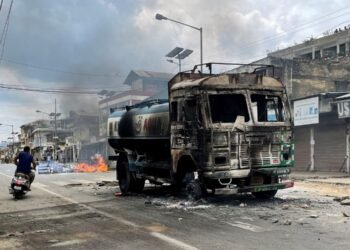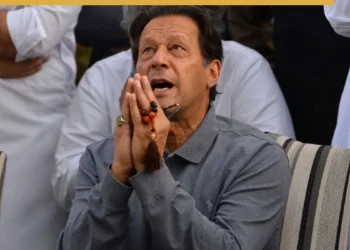“Horror Children Face in Myanmar” begins a harrowing three-part series by Navin Upadhyay. Part one of this series delves into the escalating violence against children, revealing not only the immediate terror of attacks like the recent school bombing, but also the systemic threats of displacement, trauma, and the loss of education that scar a generation.
By Navin Upadhyay
May 16, 2025:
The relentless civil war in Myanmar has plunged its children into a living nightmare, with the recent bombing of a school in O Htein Twin village, Depayin Township, Sagaing Region, serving as a horrifying illustration of the dangers they face daily. A junta fighter jet targeted the school run by the parallel National Unity Government on Monday morning, May 12, 2025, killing at least 22 young students and two teachers, and leaving over 100 others severely injured.
Myanmar’s regime has denied responsibility for the airstrike, but given its past record of brutality and routine denials, few are likely to believe its claim. Residents of O Htein Twin village told the media the attack was carried out by a junta fighter jet. Witnesses told The Irrawaddy that explosions followed the sound of the aircraft almost instantly, giving villagers no time to flee.
On Tuesday, the civilian Ministry of Human Rights reported that a jet from Meiktila Shante airbase had targeted the school. Eyewitnesses said shell casings at the scene indicated that two cluster bombs were used.
The accounts from the scene paint a gruesome picture of the attack’s brutality. Rescuers reported bodies torn apart by the blast, with Daw Yati Ohn, a witness who rushed to the site, describing seeing severed fingers, locks of hair, and bloodstains on desks and chairs. The sheer force of the explosion left holes in the ground around the school compound, a stark reminder of the lethal power unleashed on innocent children.
#BREAKING On Monday, the junta bombed a school in central #Myanmar, taking the lives of at least 20 students and 2 teachers, with more than 20 others wounded.
It is indefensible that schools and children are being targeted. Our hearts grieve for the lives of these children who… pic.twitter.com/yYyCw4fPwN
— Partners Relief & Development (@PartnersRelief) May 14, 2025
Survivors recounted the terrifying moments as their teachers urged them to flee when the aircraft returned. Upon emerging from the chaos, they were met with the horrifying sight of their friends slumped lifelessly over desks. One injured schoolgirl recalled a teacher who had just finished her class but returned to distribute worksheets, only to be struck moments later, her lower body completely gone. Another injured teacher, covered in blood, explained that it was not her own, but that of the children she had tried to save.
ALSO READ: Opinion: Boycotting Turkey, Ignoring China: India’s Misplaced Outrage?
The psychological trauma inflicted on the survivors and the families of the victims is profound. Witnesses described parents arriving at the scene to be confronted with the dismembered remains of their children. One mother, upon seeing her daughter’s upper body, was so overcome that she could only run aimlessly around the school. The emotional scars of such an event will undoubtedly run deep.
ALSO READ: Broken Promises: SoO Cadres Left Unpaid for Two Years
This horrific incident is tragically not an isolated one, highlighting the devastating impact of the ongoing conflict on Myanmar’s youngest population. In the first five months of 2025 alone, 109 children were reported killed or injured. The Pazigyi village airstrike on April 11, 2023, which killed 128 people, including 40 children, remains the single worst recorded fatal event for children since the February 2021 coup.
The violence against children in Myanmar extends beyond bombings. There are increasing reports of children being directly targeted in ground assaults, often caught in the crossfire of clashes between junta forces and resistance groups. In numerous villages, children have been killed by small arms fire during military raids. For example, in Kyaukme, Shan State, in March 2025, five children, ranging in age from 7 to 15, were killed when soldiers opened fire on civilians fleeing an attack by the Myanmar military.
ALSO READ: Opinion: MP Minister Must Be Fired for Slandering Nation’s Pride
Reports from Human Rights Watch detail instances where children have been summarily executed by junta forces, often accused of having family members involved with resistance groups. In one particularly disturbing case in Sagaing Region, three teenagers were beheaded after being detained during a military operation [Cite Source: Human Rights Watch Report].
The junta’s denial of responsibility and their attempts to frame such attacks as targeting “terrorist-linked groups” are seen by witnesses as blatant lies and excuses. The immediate response of resistance fighters to help the victims, regardless of uniforms or affiliations, highlights the desperate need to save innocent lives amidst the violence.
12 May 2025, #Myanmar military launched an airstrike targeting a school in Tabayin Twnsp, Sagaing Region, killed at least 20 students and two teachers; injured >100. While we appreciate Intl Community statements of condemnation, we urge them to cut off finance to the junta. pic.twitter.com/7fNtD5Nd6W
— Spokesperson, NUG President Office (@NUGPressSPOX) May 15, 2025
The consequence of this escalating violence is a dire threat to children’s access to education. Following the bombing, the National Unity Government’s Ministry of Education has suspended teaching activities for safety reasons. The very act of attending school has become life-threatening, forcing authorities to consider closing schools completely or seeking precarious alternatives. Beyond the immediate casualties, millions of children face displacement, lack of education, increased risk of exploitation, profound psychological trauma, and food insecurity due to the ongoing conflict. Over 3.5 million people are internally displaced, with children making up a significant portion. Millions of children have missed out on critical education due to school closures and the dangers of attending. Children are more vulnerable to forced recruitment, child labor, and early marriage. Witnessing violence and living in fear of attacks has a devastating impact on children’s mental health. Conflict disrupts essential services, leaving children vulnerable to malnutrition and preventable diseases.
As the world turned a blind eye, the civil war in Myanmar has subjected children to unimaginable brutality. The bombing of the school, resulting in the deaths of 22 students and leaving many others with horrific injuries, is a stark reminder of the extreme danger they face. These children are not merely caught in the crossfire; they are increasingly becoming direct targets of violence, robbed of their safety, their education, and tragically, their lives. The deep emotional scars and the disruption of education will have long-lasting consequences for an entire generation of Myanmar’s children. The staggering number of children killed and injured underscores the urgent need for international intervention to protect the innocent and end the devastating cycle of violence. The situation for children in Myanmar remains dire, and international organizations continue to call for the protection of children and an end to the violence.
The impact of the civil war on children extends far beyond just the number of deaths. Millions of children face:
- Displacement: Over 3.5 million people are internally displaced, with children making up a significant portion.
- Lack of Education: Millions of children have missed out on critical education due to school closures and the dangers of attending.
- Increased Risk of Exploitation: Children are more vulnerable to forced recruitment, child labor, and early marriage.
- Psychological Trauma: Witnessing violence and living in fear of attacks has a devastating impact on children’s mental health.
- Food Insecurity and Lack of Healthcare: Conflict disrupts essential services, leaving children vulnerable to malnutrition and preventable diseases.
The situation for children in Myanmar remains dire, and international organizations continue to call for the protection of children and an end to the violence.













